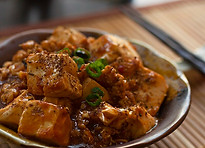SpiceUpSichuan
燃趣四川
By成都图兰多贸易有限公司

川菜 Sichuan Food
川菜以成都和重庆两地的菜肴为代表。所用的调味品有花椒、胡椒、辣椒,合稱“三椒”;葱、姜、蒜,合称“三香”;用的最多的有郫县豆瓣,永川豆鼓等调味酱,以调味为重点的有“鱼香”、“怪味”等菜。
川菜的风格朴实而又清新,官家川菜精细别致,农家川菜具浓厚的乡土气息。
川菜有“七滋八味”之说,“七滋”指甜、酸、麻、辣、苦、香、咸; “八味”即是鱼香、酸辣、椒麻、怪味、麻辣、红油、干烧、干炒。
川菜突出的是麻、辣、香、鲜及油大、味厚的特点,重用“三椒”和鲜姜。 在7种基本味型的基础上,又可调配变化为多种复合味型。
川菜的复合味型有24多种,如咸鲜味型、家常味型、麻辣味型, 等等。
Most Sichuan dishes are spicy, although a typical meal includes non-spicy dishes to cool the palate.
Sichuan cuisine is composed of seven basic flavours: sour, pungent, hot, sweet, bitter, aromatic and salty.
Sichuan food is divided into five different types: sumptuous banquet, ordinary banquet, popularised food, household-style food and snacks. Sichuan cuisine often contains food preserved through pickling, salting and drying. Preserved dishes are generally served as spicy dishes with heavy application of chili oil.
Sichuan cuisine is the origin of several prominent sauces/flavours widely used in modern Chinese cuisine, including Yuxiang (魚香 fish flavor), Mala (麻辣 spicy & tingling) and Guaiwei (怪味 exotic taste).
There are many local variations within Sichuan Province and the neighbouring Chongqing Municipality, which was part of Sichuan Province until 1997. Four sub-styles of Sichuan cuisine include Chongqing, Chengdu, Zigong and Buddhist vegetarian style.
UNESCO declared Chengdu, the capital of Sichuan Province, to be a city of gastronomy in 2011 to recognise the sophistication of its cooking.
一些川菜 Some Sichuan Food
四川火锅 Sichuan Hot Pot
Sichuan hotpot is a spicy, numbing, and flavorful dining experience where ingredients are cooked in a rich, chili-infused broth.
四川火锅是一种麻辣鲜香的美食体验,将食材放入浓郁的辣汤中烹煮。

By Jpatokal - Own work, CC BY-SA 4.0, https://commons.wikimedia.org/w/index.php?curid=125475779
麻婆豆腐 Mapo Tofu
A spicy, numbing dish of silken tofu in a rich, chili and Sichuan peppercorn-infused sauce with minced pork.
麻辣浓郁的豆腐佳肴,嫩滑豆腐配上辣椒和花椒调味的肉末酱汁。

Di Archon6812 - Opera propria, CC BY-SA 3.0, https://commons.wikimedia.org/w/index.php?curid=17351480
回锅肉 Twice-Cooked Pork
Sichuan hotpot is a spicy, numbing, and flavorful dining experience where ingredients are cooked in a rich, chili-infused broth.
种麻辣鲜香的美食体验,将食材放入浓郁的辣汤中烹煮。

作者 Guilhem Vellut from Paris, France - Twice cooked pork @ Jia Yan @ Paris,CC BY 2.0,https://commons.wikimedia.org/w/index.php?curid=56433770
担担面 Dan Dan Noodles
Spicy Sichuan noodles topped with minced pork, chili oil, and preserved vegetables in a tangy, numbing sauce.
麻辣酸爽的四川小面,搭配肉末、辣油和酸菜。

作者 Steven G. Johnson - 自己的作品,CC BY-SA 3.0,https://commons.wikimedia.org/w/index.php?curid=4381140
酸菜鱼 Boiled Fish with Pickled Cabbage
Tender fish fillets simmered in a tangy, spicy broth with pickled mustard greens and Sichuan peppercorns.
鲜嫩鱼片煮在酸辣浓汤里,搭配酸菜和花椒。
.jpg)
作者 Alpha from Melbourne, Australia - 酸菜鱼 Preserved Mustard Green with Fish - Charming Spice AUD24.80,CC BY-SA 2.0,https://commons.wikimedia.org/w/index.php?curid=48412584
宫保鸡丁 Kung Pao Chicken
A sweet, spicy, and nutty dish made with diced chicken, peanuts, dried chilies, and a rich soy-based sauce.
甜辣交融的美味,鸡丁搭配花生、干辣椒和浓郁酱汁炒制。

By Steven G. Johnson - Own work, CC BY-SA 3.0, https://commons.wikimedia.org/w/index.php?curid=4538129
棒棒鸡 Bang Bang Chicken
A Sichuan dish of shredded chicken with a spicy, nutty sesame sauce. The name comes from pounding the chicken to make it tender.
四川名菜,鸡肉撕碎后拌入麻辣芝麻酱,因敲打鸡肉使其更嫩而得名。

rick, CC BY 2.0 <https://creativecommons.org/licenses/by/2.0>, via Wikimedia Commons
鱼香肉丝 Fish Flavoured Shredded Pork
A classic Sichuan dish with shredded pork stir-fried in a sweet, sour, and spicy sauce with garlic, ginger, and pickled chilies. Despite the name, it contains no fish.
四川经典菜,肉丝搭配酸甜麻辣酱汁翻炒,含蒜姜和泡椒,尽管名字带“鱼香”,却不含鱼。
.jpg)
N509FZ, CC BY-SA 4.0 <https://creativecommons.org/licenses/by-sa/4.0>, via Wikimedia Commons
酸辣汤 Hot and Sour Soup
A warming soup with a spicy, tangy broth filled with tofu, mushrooms, egg, and sometimes meat, flavored with vinegar and white pepper.
经典中式汤品,酸辣浓郁,内含豆腐、蘑菇、鸡蛋,有时加肉,以醋和白胡椒调味。

Calgary Reviews, CC BY 2.0 <https://creativecommons.org/licenses/by/2.0>, via Wikimedia Commons
四川凉面 Sichuan Cold Noodles
A refreshing noodle dish tossed in a spicy, garlicky, and nutty sesame sauce, with a numbing kick from Sichuan peppercorns.
清爽开胃的面食,拌入麻辣蒜香芝麻酱,带有花椒的微麻口感。
